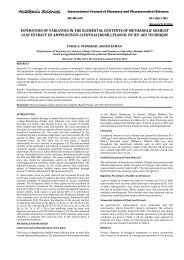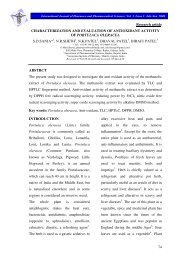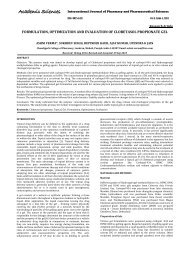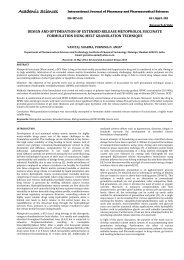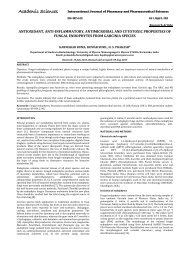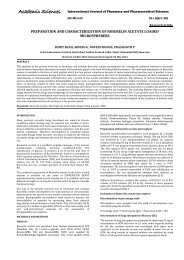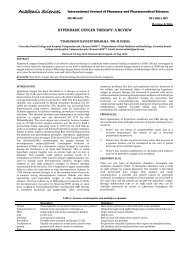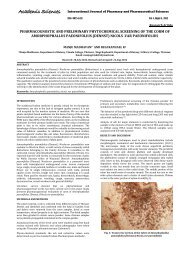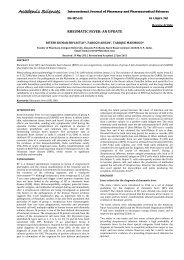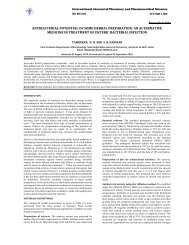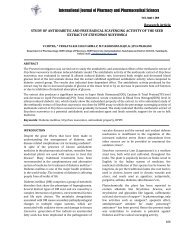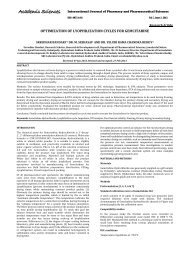frequency and attitudes of using hair dyes among palestinian women
frequency and attitudes of using hair dyes among palestinian women
frequency and attitudes of using hair dyes among palestinian women
Create successful ePaper yourself
Turn your PDF publications into a flip-book with our unique Google optimized e-Paper software.
Zaid et al.<br />
Int J Pharm Pharm Sci, Vol 5, Suppl 2, 485-488<br />
Among those who prefer natural <strong>dyes</strong>, 41 (70.1%) <strong>of</strong> them told that<br />
they add other natural materials to henna; the main natural<br />
materials were hibiscus, tea <strong>and</strong> chamomile. Twenty five declared<br />
that the motivation behind the addition <strong>of</strong> these natural materials<br />
was to reach the required degree <strong>of</strong> color, while 10 <strong>of</strong> them added<br />
natural materials to increase the adherence <strong>and</strong> permanence <strong>of</strong><br />
color on <strong>hair</strong> <strong>and</strong> only a minority <strong>of</strong> the interviewed females (6) had<br />
this practice due to their beneficial effects on the <strong>hair</strong>. When the<br />
consumers were asked to give the reasons behind the preference <strong>of</strong><br />
natural <strong>dyes</strong>, 23 out <strong>of</strong> the 58 said that was because they are safer<br />
than chemical <strong>dyes</strong>, 15 said that natural <strong>dyes</strong> give them the best<br />
natural color results, <strong>and</strong> 20 used natural <strong>dyes</strong> because they think<br />
they are useful to the scalp (Table 1).<br />
Table 1: It shows the reasons behind the preference <strong>of</strong> natural <strong>dyes</strong><br />
Reason Frequency (%) ( N = 58)<br />
They are safer than chemical <strong>dyes</strong> 23 (39.7%)<br />
They give the best natural color 15 (25.9%)<br />
They are useful to the scalp 20 (34.4%)<br />
Regarding any experience <strong>of</strong> side effects after <strong>using</strong> henna 8 out <strong>of</strong><br />
58 (13.8%) reported that they have experienced side effects due to<br />
the use <strong>of</strong> natural <strong>dyes</strong> as headache, contact allergic dermatitis, <strong>and</strong><br />
chemical burns.<br />
Synthetic <strong>dyes</strong> & motivation <strong>of</strong> consumer preference<br />
Among the consumers who declared that they preferred chemical<br />
<strong>dyes</strong>, 40 out <strong>of</strong> 91 (44%) said that the reason behind their<br />
preference <strong>of</strong> chemical <strong>dyes</strong> was that they are easier to use (require<br />
shorter time on <strong>hair</strong> <strong>and</strong> can be washed easily). Twenty four <strong>of</strong> the<br />
females preferred chemical <strong>dyes</strong> to obtain the required degree <strong>of</strong><br />
color, <strong>and</strong> 27 <strong>of</strong> them chose chemical <strong>dyes</strong> because they give wider<br />
options when choosing color (Table 2).<br />
Table 2: It shows the reasons behind the preference <strong>of</strong><br />
chemical <strong>dyes</strong><br />
Reason Frequency (%) ( N = 91)<br />
They are easier than natural <strong>dyes</strong> 40 (44%)<br />
They give the required degree <strong>of</strong> color 24 (26.4%)<br />
They give wider options <strong>of</strong> colors 27 (29.6%)<br />
The consumers were asked if they have suffered from any <strong>of</strong> the side<br />
effects that could be related to chemical <strong>hair</strong> <strong>dyes</strong>, the reported side<br />
effects were trichorrhexis (40.7%), itching <strong>and</strong> redness <strong>of</strong> the scalp<br />
(20.4%), <strong>and</strong> <strong>hair</strong> loss (29.6%).<br />
Preferred place to get chemical <strong>hair</strong> <strong>dyes</strong><br />
Concerning the ideal place to get the desired <strong>hair</strong> <strong>dyes</strong>, stores or<br />
supermarkets were chosen by 15 out <strong>of</strong> 91 (16.5%) <strong>of</strong> the females,<br />
28 (30.8%) <strong>of</strong> the females depended on community pharmacies to<br />
achieve their <strong>hair</strong> <strong>dyes</strong>, while more than half <strong>of</strong> them 48 (52.7%)<br />
declared that the beauty salon was their preferred place to get <strong>hair</strong><br />
<strong>dyes</strong>.<br />
Safety <strong>of</strong> <strong>hair</strong> <strong>dyes</strong> <strong>and</strong> use during pregnancy <strong>and</strong> lactation<br />
When <strong>women</strong> were asked if they have ever used any type <strong>of</strong> <strong>hair</strong><br />
<strong>dyes</strong> during pregnancy or breast-feeding, only 11 out <strong>of</strong> 149 (7.4%)<br />
said yes. When consumers were asked if they think that <strong>hair</strong> <strong>dyes</strong><br />
may cause cancer 32 (21.5%) <strong>of</strong> the females answered with yes with<br />
only 9.3% <strong>of</strong> them opted to consult a doctor or a pharmacist.<br />
DISCUSSION<br />
In this study, 149 (74.5%) <strong>of</strong> the females said that they have used<br />
<strong>hair</strong> <strong>dyes</strong>. These results are similar to other countries where a high<br />
percentage <strong>of</strong> <strong>women</strong> use <strong>hair</strong> <strong>dyes</strong>. In a survey from Saudi Arabia,<br />
82.6% <strong>of</strong> the participating females had dyed their <strong>hair</strong> at some point<br />
in their lives [7]. In Denmark 74.9% <strong>of</strong> <strong>women</strong> <strong>and</strong> 18.4% <strong>of</strong> men<br />
had at some point dyed their <strong>hair</strong>, <strong>and</strong> the median age for first use <strong>of</strong><br />
<strong>hair</strong> dye for both men <strong>and</strong> <strong>women</strong> was during the teenage years [8].<br />
About one third <strong>of</strong> <strong>women</strong> in Europe <strong>and</strong> North America, along with<br />
10% <strong>of</strong> men older than 40 years, use some type <strong>of</strong> <strong>hair</strong> dye [9]. Hair<br />
coloring is a dye that is used to color human <strong>hair</strong>. It is used for a<br />
variety <strong>of</strong> purposes; most commonly to return gray <strong>hair</strong> to its<br />
previous color, to change <strong>hair</strong> color to a more desirable shade, or to<br />
return <strong>hair</strong> to its original color after chemicals (e.g. <strong>hair</strong> dye) have<br />
discolored it [7]. The major motivation for <strong>hair</strong> dyeing in this study<br />
was to simply have a change <strong>of</strong> color <strong>and</strong> follow new trends (52.3%);<br />
other reasons were to improve the outlook by 24.2% <strong>and</strong> to hide<br />
gray <strong>hair</strong> by 23.5%. Concerning the type <strong>of</strong> <strong>hair</strong> <strong>dyes</strong> preferred by<br />
consumers, natural <strong>dyes</strong> (henna) were the choice for 58 (38.9%) <strong>of</strong><br />
the females. This shows that henna is widely used in our community.<br />
This can be expected as the use <strong>of</strong> henna dye is traditional in Islamic<br />
countries. It has a religious <strong>and</strong> social significance <strong>and</strong> it thought to<br />
be safe. In fact, when the consumers were asked to give the reasons<br />
behind the preference <strong>of</strong> natural <strong>dyes</strong>, 39.7% <strong>of</strong> them said that was<br />
because they are safer than chemical <strong>dyes</strong>, 25.9% <strong>of</strong> them said that<br />
natural <strong>dyes</strong> give them the best normal results. An interesting<br />
number <strong>of</strong> interviewed females (34.4%) declared that henna is<br />
beneficial to the scalp which may be investigated in a future<br />
research. Eight out <strong>of</strong> 58 (13.8%) reported that they have<br />
experienced side effects due to the use <strong>of</strong> natural <strong>dyes</strong> as headache,<br />
contact allergic dermatitis, <strong>and</strong> chemical burns.<br />
Regarding the safety, despite the wide spread use <strong>of</strong> natural henna,<br />
especially, in countries where henna art is traditionally practiced;<br />
reports <strong>of</strong> allergic contact dermatitis to natural henna are very rare<br />
in the literature. It can therefore be assumed that natural henna is a<br />
very weak skin allergen [6,10], <strong>and</strong> these allergic observations may<br />
be due to the addition <strong>of</strong> other components to henna in order to<br />
improve the quality <strong>of</strong> this product in terms <strong>of</strong> final color, time<br />
required to achieve the desired color <strong>and</strong> its lasting effect. In fact,<br />
these properties were reported by the consumers when they were<br />
asked about the motivations behind the addition <strong>of</strong> other home<br />
additives to henna. Indeed, this was confirmed by consumers who<br />
preferred the chemical <strong>dyes</strong>. Therefore, this may encourage some<br />
manufacturers to mix henna with other chemical <strong>dyes</strong> such as paraphenylenediamine<br />
(PPD), without mentioning these additives on the<br />
label <strong>of</strong> henna packages <strong>and</strong> this may be dangerous due to possible<br />
toxic effects <strong>of</strong> these added chemicals. In fact, PPD has been mixed<br />
with natural henna to give an ebony color (black henna) instead <strong>of</strong><br />
the orange/reddish color given by natural henna. The other reason<br />
for adding PPD to the natural henna is to speed up (shorten the<br />
time) <strong>of</strong> the tattooing <strong>and</strong> dyeing process, while natural henna<br />
staining takes 4 to 12 hours, addition <strong>of</strong> PPD can reduce this time to<br />
an hour or two <strong>and</strong> also there will be a longer lasting effect as well<br />
[5]. Thus, a new pattern <strong>of</strong> exposure to PPD has been recognized<br />
through henna which increases the risk <strong>of</strong> developing adverse health<br />
effects related to PPD. Acute allergic contact dermatitis, eczema,<br />
chemical burn, acute renal failure, acute <strong>and</strong> severe angioneurotic<br />
edema, abdominal pain <strong>and</strong> vomiting as adverse health effects<br />
associated with the use <strong>of</strong> henna containing PPD (black henna) are<br />
well documented in the literature [5]. It is also documented that PPD<br />
can bring about rhabdomyolysis which is the main cause <strong>of</strong> acute<br />
renal failure [11].<br />
It is good to mention that many other herbs like Kikar (Acacia<br />
arabica), bihi (Cydonia oblonga), bhringraj (Eclipta alba), patnag<br />
(Haematoxylon campechianum), akhrot (Juglans regia), narra<br />
(Petrocarpus inducus) <strong>and</strong> jabor<strong>and</strong>i (Pilocarpus jabor<strong>and</strong>i) can be<br />
used as a main ingredients in <strong>hair</strong> care preparations mainly for<br />
dyeing <strong>hair</strong> [12], Some other herbs as Emblica <strong>of</strong>ficinalis, Centella<br />
asiatica, Aloe vera, Ocimum sanctum <strong>and</strong> Eclipta can be used to<br />
improve <strong>hair</strong> growth [13]. So in summary, we can say that natural<br />
products might be safer than chemical products but they are not<br />
completely free from possible side effects <strong>and</strong> <strong>women</strong> need to know<br />
this in order to protect their health, <strong>and</strong> thus more public health<br />
awareness efforts must be conducted within communities <strong>using</strong><br />
them.<br />
Henna producers should not mix it with these chemicals or at least<br />
should provide henna packs with a label that contain complete<br />
information about the ingredients present in the provided henna<br />
formulation, since most consumers use it due to its claimed safety<br />
when compared with chemical <strong>dyes</strong>. Also, regulatory bodies should<br />
analyze <strong>and</strong> check on the quality <strong>of</strong> the henna packs arriving from<br />
various sources to check for presence <strong>of</strong> harmful ingredients or<br />
undisclosed ingredients <strong>and</strong> assure its freedom from the presence <strong>of</strong><br />
such chemicals. It is also a good idea to pose restrictions on points <strong>of</strong><br />
486



